It’s been well established on this blog that Hugh Morton was a huge music fan, and there are many images in the collection that relate to music, musicians, and music history: swing, jazz, gospel, folk, and other traditional music from a variety of traditions. Continuing in this series of entries, I would like to present the Durham-born musician John D. Loudermilk.
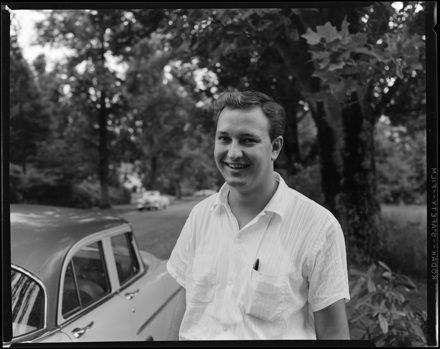 The cousin of Ira and Charlie Loudermilk (better known as the Louvin Brothers), John Loudermilk was born in Durham, NC in 1934. Also known as “Johnny Dee” and, occasionally, “Ebe Sneezer” (of Ebe Sneezer and the Epidemics), Loudermilk has been involved with music as a singer, songwriter, and ethnomusicologist. He has written and performed within the context of several genres, including 1950s teen rock and roll, blues, and country music (a biography on CMT.com calls him “incredibly erratic” and “one of the weirdest figures of early rock & roll,” in part due to his ability to evade classification).
The cousin of Ira and Charlie Loudermilk (better known as the Louvin Brothers), John Loudermilk was born in Durham, NC in 1934. Also known as “Johnny Dee” and, occasionally, “Ebe Sneezer” (of Ebe Sneezer and the Epidemics), Loudermilk has been involved with music as a singer, songwriter, and ethnomusicologist. He has written and performed within the context of several genres, including 1950s teen rock and roll, blues, and country music (a biography on CMT.com calls him “incredibly erratic” and “one of the weirdest figures of early rock & roll,” in part due to his ability to evade classification).
Our fellow Wilson Library occupant, the Southern Folklife Collection, holds the definitive John D. Loudermilk Collection of sheet music, correspondence, memorabilia, recordings, and other materials. They kindly provided us with an audio clip of “Tobacco Road,” below. As CMT.com says of the song, “if he’d written nothing else, Loudermilk would have been worth a footnote in any history of popular music.” Recorded in 1960 as a folk song, it soon became a cross-genre favorite, performed by such disparate acts as The Nashville Teens, Jefferson Airplane, David Lee Roth, and Eric Burdon & War.
>> PLAY “Tobacco Road” by John D. Loudermilk <<
We know that Loudermilk and Hugh Morton shared two connections: businessman Orville Campbell and musician George Hamilton IV. From the beginning of his career until 1958, when he signed with Columbia and moved to Nashville, Loudermilk recorded for the NC-based Colonial Record label. Orville Campbell, a close friend of Morton’s, owned the Colonial label and reputedly “discovered” John Loudermilk. Campbell can be seen here, circa 1954, in the loving embrace of another mutual friend, Andy Griffith:
Meanwhile, Loudermilk and George Hamilton IV (also a Colonial artist) had a decade-spanning collaboration which began with the 1956 hit song, “A Rose and a Baby Ruth” (click here to hear it and watch an incredibly silly YouTube video). The song about teenage love, suffused with a kind of quiet, boyish optimism, made stars out of Loudermilk and Hamilton. Hugh Morton took this picture of Hamilton at Grandfather Mountain probably somewhere around that same time. (Note that the Southern Folklife Collection also holds the George Hamilton IV collection).
I would love to know more about some photos of Loudermilk in the Morton Collection. The first image in this post and the images below were labeled as being taken at an August 22, 1957 recording session. The biggest hit Loudermilk had in 1957 was the song “Sitting in the Balcony,” but that was, according to the extensive Loudermilk fan site ihesm.com, recorded in February. Might these have been taken during the recording of “Teenage Queen,” cowritten by Campbell? And/or “My Big Brother’s Friend,” with Cecelia Batten? (That sure looke like Batten in the second image below).
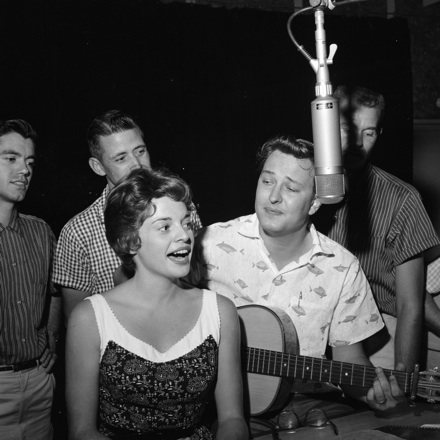 This image of Loudermilk serenading Governor Luther Hodges and others on an airplane seems to be unrelated to the recording process, though it is likely the picture was taken some time between 1956 and 1958, when Loudermilk still lived in North Carolina and Hodges was Governor.
This image of Loudermilk serenading Governor Luther Hodges and others on an airplane seems to be unrelated to the recording process, though it is likely the picture was taken some time between 1956 and 1958, when Loudermilk still lived in North Carolina and Hodges was Governor.
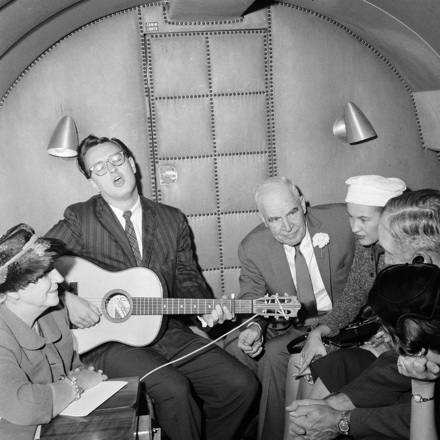 Some detailed research in the John D. Loudermilk Collection might reveal answers. Or perhaps we’ll hear from Loudermilk himself?
Some detailed research in the John D. Loudermilk Collection might reveal answers. Or perhaps we’ll hear from Loudermilk himself?

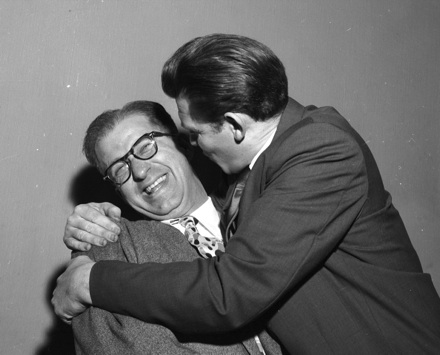
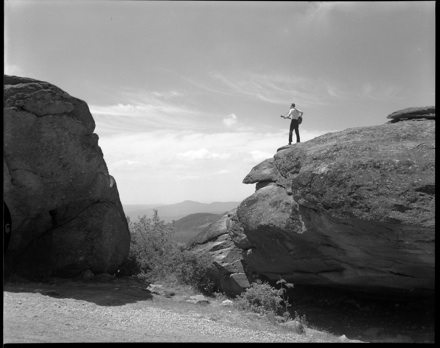
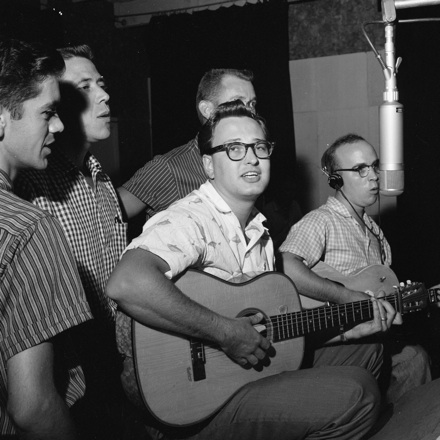
A most enjoyable and informative post, David. Before I read it I didn’t know very much about John D. Loudermilk. I had seen the Morton image in the 1988 book “Making A Difference In North Carolina” (page 105) and I knew he was a musician but that’s about it. His connection with Orville Campbell is very interesting to me because Campbell is a long-time Chapel Hill hero of mine. I first heard the name Orville Campbell back in the fall of 1949 when he, along with Hank Bebee, wrote the song “All The Way Choo Choo,” honoring my friend Charlie Justice. That song was recorded on King Records by bandleader Johnny Long and sold about 32,000 copies across North Carolina. (It has often been reported that “All The Way Choo Choo” was also recorded by Benny Goodman, but I have not been able to find such a recording. There is a Goodman arrangement of the song and it was performed by his band live in concert. But that’s another story for another time.)
Campbell, in addition to his song writing, was a photographer, news reporter, editor, and publisher. He was the founder and CEO of Colonial Publishing and Colonial Records…both based in Chapel Hill.
In addition to the songs he produced with John D. Loudermilk, Campbell produced records with baseball legend Dizzy Dean, Andy Griffith, WPTF Announcer Phil Ellis, Hoke Simpson, Billy “Crash” Craddock, and a Chapel Hill group called The Belltones. I guess one of the most successful recordings was the Andy Griffith monologue called “What It Was Was Football,” which was recorded first on Colonial Records then released to Capitol Records. Hugh Morton claims at least partial credit for getting Andy and Orville together. As Morton tells the story, back in April of 1953 he was hosting a banquet at the Carolina Inn and needed an entertainer. Someone suggested a young graduate student who was active in the Playmaker’s Theater. Morton was able to hire the student for $25. The student’s name was Andrew Griffith, and he delighted the audience with a hilarious monologue about a bumpkin at his first football game. Campbell was in the audience that night and after the show rushed up to meet Andy and eventually signed him to a contract.
Campbell, along with Bebee, also wrote “Way Up In North Carolina.” That song was performed by The Belltones, released on Colonial Records, and was profiled by “The State Magazine” in the September 15, 1951 issue (pages 5 and 21.)
I looked up an Orville Campbell profile that “Winston-Salem Journal” feature writer Tom Seig wrote on January 31, 1988. (The name Tom Seig will be familiar to Hugh Morton fans for his work on the 1995 Morton PBS documentary “The Search For Clean Air.”)
Seig relates the Loudermilk – Hamilton – Campbell connection. According to Seig, George Hamilton IV came to Chapel Hill about two years after Andy and his football tale. Hamilton wanted to be a star at the Grand Ole Opry so he sent Campbell an audition tape. Campbell’s advice was for Hamilton to pursue his dream by writing his own songs. So he wrote several songs, but had little success. Then one day he met Campbell’s friend John D. Loudermilk, who had written a sentimental number about a boy who could give his girlfriend only a single flower and a candy bar. Said Seig, “Hamilton hated the song, and Loudermilk hated the way Hamilton sang it, but Campbell loved them both.” So “A Rose and a Baby Ruth” was recorded and as they say the rest is history. A side note…soon after the song was released, Orville Campbell received a letter from the candy company saying he had violated their copyright. Before Campbell could get his legal team in place, a second letter came saying forget the first letter. Candy bar sales were increasing at a rapid rate.
One final Orville Campbell story. Orville was a roaster at a Charlie Justice Juvenile Diabetes roast on April 30, 1984 in Charlotte and related this story:
“We always liked to take our songs over to Mr. W.D. Carmichael, then acting University President, and get his opinion. So when we finished ‘All The Way Choo Choo,’ I went over to his office. He was extremely busy that day, but I went in anyway. His desk was covered with papers and he didn’t look up. ‘What do you want, Orville?’ I just wanted to know if you had heard our last song? ‘I hope the h— I have’ was the reply.”
Campbell, like Hugh Morton, was a North Carolina treasure.
Orville Bentley Campbell died on June 6, 1989. He was 69 years old.
Hey!”Romeo and Juliet was on the back of “What it was was Football”, two great monologues for tyhe price of one!
Johnny Dee came to the Singing on the Mountain the year Hugh made a black and white movie about the Singing. He sang “Amazing Grace” for the film. It was before TV had upstaged live performances to the extent to which it has now and huge crowds turned out to see Arthur Smith and the Crackerjacks, the Harvesters, and other very popular groups. I believe the Harvesters sang “I am a Pilgrim” in the film. Am I remembering correctly that one of those gentlemen served in Congress for many years? (I am ashamed I can’t remember his name just this moment but I can trust Jack to know.) George Hamilton IV still comes to the Singing every year, and is a very dear friend. I think Hugh shot the picture of him you show here for an albulm cover. Orville and Hugh’s friendship went as far back as their college years. It always seemed to me that they both collected celebrities like boys collect baseball cards. We met Otto Graham and Ted Williams through Orville, Clyde King and countless other sports figures and entertainers. I believe we were a while meeting Boots Randolph, but I remember Orville talking about him. Later Boots came to the Singing several times, and his last performance may have been at the Singing because he died of a heart attack just a few days later. The nice thing was that our well known friends remained friends. The famous photographers and political figures Hugh added to the mix, and it was a wonderful mix.
You don’t need me to tell you that Gov. and Mrs. Hodges are shown above with John, but Sarah Harden is also in the picture and John Harden is beside her. I has hair as dark as the lady whose wrist watch shows clearly, but it couldn’t be me because I never had a hat like that.Besides, I stayed home raising children most of the time. However the group is clearly flying somewhere where Johnny Dee was going to represent North Carolina talent. (George Hamilton went to England with one group of NC ambassadors once when I did get to go.)
I’m thinking the singing Congressman was W. G. “Bill” Hefner, a Concord radio station owner who represented the 8th District, 1975-99.
Yes, Julia, Lew Powell beat me to it, but the Harvesters did a weekly TV show at WFMY-TV back in the mid-1960’s and I worked on some of those shows. I believe the gentleman you’re thinking of is Bill Hefner.
http://en.wikipedia.org/wiki/Bill_Hefner
Check out Field Trip South‘s tribute to Loudermilk!
Thanks for all of the information Jack and Julia. Its great to learn more about Orville Campbell (as well as his famous friends), and I look forward to learning more about the Colonial Record label.
Lew, that information on Bill Hefner will be really helpful, and I look forward to seeing images of Smith, Hefner, and the rest of the Harvesters in the collection.
Julia, do you know an approximate year for that black-and-white “Singing” movie?
Wish I could help you, Elizabeth. My only clues are that Johnny D. was just starting out on his very illustrious career and the half hour film was black and white, which might hve put it mid-fifties. I always thought it was a very good film. I hope you can find it. And, of course, it was Congressman Bill Hefner whose name wouldn’t come to me.
By the way, Catherine is the family expert on Johnny D.
Elizabeth and Julia…if the “Singing” black and white film featured a song by the Harvesters and if Bill Hefner was with the group at that time, then we can put it between 1954 – 1967. Hefner was with the group during those years. And according to David’s post, Loudermilk left North Carolina in 1958 when he signed with Columbia and moved to Nashville. So Julia the mid-1950’s sounds correct.
I’m pretty sure that the photograph of Andy Griffith and Orville Campbell was made at the Honorary Tar Heels dinner in New York City on 21 January 1956. Check out their ties in the group photograph in the “Don’t Smoke Your Eye” Out” post: https://blogs.lib.unc.edu/morton/index.php/2009/06/dont-smoke-your-eye-out/
We found a film labeled “WBTV ’56 Color Sing.” Obviously not B&W, but maybe filmed at the same time? (Though maybe by WBTV)?
Sad news today with the passing of Bill Hefner…
http://www.salisburypost.com/Area/090309-hefner-obit-bill-hefner-dies
These are fantastic early JDL-pictures. Thank you so much for publishing them!
The session photo from August could be the Ebe Sneezer recording. Some session data details are on
http://countrydiscography.blogspot.com/search/label/Loudermilk%20John%20D.
The group present could well be the Colonial houseband The Bluenotes.
The presence of probably Cecelia Batten could mean that here the Loudermilk-Batten duet Freckles/ Goin’ Courtin’ was recorded (never released) or the Batten follow-up to her hit record, Knock on the Pipes (Colonial 732).
I will try to find out conformation about these suggestions, in contacting my Bluenotes-Loudermilk-Batten contacts.
In the photo with John surrounded by four men … Joe Tanner (my Second Cousin) is on the right playing guitar and singing. His group The Bluenotes, backed John, George Hamilton IV and other Colonial Label acts. They also had a brush with success as a group (with releases on both the Colonial and Brooke label) and made one appearance on American Bandstand in late ’59.
The group consisted of Joe Tanner, Tom Underwood, Ralph Harrington and Pat Patterson.
Joe eventually was noted for three major contributions. He wrote ‘Evergreen’ a Roy Orbison million seller, He was arranger and conductor of ‘In Dreams’ for Roy on Monument Records and he was Thee Guitar lead on the original recording of ‘Oh Pretty Woman’
Joe Tanner also did the great guitar work on “If You Don’t Know,” the flip side of George Hamilton IV’s recording of Loudermilk’s tune, “A Rose And a Baby Ruth”
Hello. Interesting forum on a great artist John D Loudermilk and thanks for the great information. I heard JD still lives in Durham, NC but not sure if he does any appearances at present.
Cheers to all.
Regarding the photo on the plane with the Governor:
In 1957 I was invited by Orville and Hugh to go with Governor Hodges to New York to help raise awareness and promote North Carolina’s new Research Triangle.
This photo was taken aboard the governor’s plane while I was singing “Asiatic Flu”. There is a sneeze that occurs in the song, and the governor knew it was coming and took out his handkerchief and held it over his face, and we all laughed.
After my performance in New York at the National Press Club luncheon and presentation we started back home. On the way we stopped in Maryland to attend the University of North Carolina vs. University of Maryland football game. Being the youngest in the entourage I rode in the reversed back seat of a station wagon and was amazed when we drove right into the stadium full of thousands of people, all applauding. We pulled up at the 50 Yard Line and Orville said that we would be sitting in the box with the Queen of England, who was on her first trip to America and had expressed interest in American football. Everybody lined up to meet the queen, and I, last in line, asked Orville “How do you meet a queen?” He said “Just do like the guy in front of you does.” Well, one guy wanted to shake her hand and one tried to hug her neck. One guy started down on one knee, and a fellow standing next to the queen smiled and slowly shook his head. When my turn came I just shrugged and smiled and held out my hands, palms up. She smiled back and put out her hand, and we shook hands. Later on, during the game, a flask came down the row, and when I took a drink I realized it was moonshine. When it reached the queen she took a sip behind her purse and passed it on.
Years later I was in London for a TV taping, and told this story to a bunch of BBC producers in the control room during the ceremonial Opening of Parliament. When the queen appeared I said “I drank moonshine with that girl.” They turned down the monitor and said in unison “You did what?!”
Thanks, John, for sharing these stories. I really did laugh out loud as I was reading them!
If anyone knows how to contact Mr. Loudermilk please let me know. I’d like to use his song Tobacco Road in a play. Mike@mikewileyproductions.com
Thanks
MW
I have an autograph of a Johnny Dee from Buck Lake Ranch, Angola, Indiana dated around 1964. Is this from Loudermilk? Thanks!
I’ve been a fan of John’s since the early 60’s. I was stationed at an isolated Canadian location in the Canadian Arctic, 1500 miles from anywhere–no telephones, no radio stations (except for sporadically the USAF station at Thule Greenland), and dark from October to February. A friend with the US Weather Bureau (USWB), and I (and others on the base) spent many good times, dreaming of home and listening to Alabama Bound in particular but also the rest of the songs on the LP–Google Eyes, Tobacco Road, Road Hog (can still hear that siren!), Bully of the Beach, He’s Just a Scientist, Rhythm and Blues,etc. I forget the name of the LP but it got a lot of play in that isolated Arctic station.
After eventually getting ‘South’ I recall quite a few years later watching a Network TV program, I believe from WSM and listening closely to a guy sitting on a stool with a guitar and doing some song. I remember thinking, ‘this guy is REALLY good’ and imagine my surprise when the song was over and it was John D doing a guest spot on whatever show it was. I got to thinking it was high praise for him when I liked him again without knowing it was him!! You gave a lot of people some tremendous listening hours John and we can still enjoy you on You Tube! All the best from one of your many fans. Cheers.
We just saw John on Marty Stuart’s tribute show to him. He sang and played and reminded us all how very wonderful he is. Connie Smith got to sing “Then You Can Tell Me Goodbye”; Marty, The Superlatives and Leroy Troy (with Mike Armistead) all sang songs by John. It was a joyous night!
John is my uncle! I am trying to find him as well. I contacted a lady in Durham NC and she said he has passed…is this true?
I don ‘t know if I am related to John, Charles, or Linda but we do have the same last name….and I proud to be a Loudermilk! There are many others that are still around….North Carolina, Tennessee, Kentucky….I have two brothers…. John, and Robert in Louisville, Ky….and Sister Ruth in Advance, North Carolina…I’m in South Florida….my nephew is Phillip Laudermilk in Tennessee….
Johnny was friends with my three brothers in Durham, N.C. We attended the Salvation Army together. I wonder if he still remembers us.
My husband name is Robert (Bob) Yates. He tell a story about you and him in Durham North Carolina, in the third grade playing together. He said that every one like you and you were such a swell guy. Every one call you Buttermilk, and you just laugh about it. He talks about you often and the song you wrote, a Rose and Babyruth. My husband will be 83 years old in June. You are on of the most value memory he has. I think it is so wonderful to remember old friends like he does. Thank you for your time, and bless day.
Along with David Meincke, I would like to gather more information about the Colonial record label. I have been assembling a discography for the label that is improving on what is available online at:
http://www.bsnpubs.com/london/colonial/colonial.html
Would appreciate any help in filling in gaps.
Ken:
Back on August 15, 2009, I commented on David Meincke’s post and that comment can be found at the beginning of the comment section of this blog, so I won’t repeat myself, but I will add an additional comment or two…
I met Orville Campbell in August of 1973 when I was working on a TV documentary about my friend Charlie Justice. Long before I met him, I was an admirer of his work. He started The Colonial Press, Inc. back in 1947 and Colonial Records in 1951.
I have a few items that may or may not be of interest to you and your research.
(A) I have a 45 record of Andy Griffith’s “What it was, was Football!” It is a Capital record numbered EAP-1498. On the other side is Griffith’s version of “Romeo & Juliet.”
(B) I also have a piece of sheet music (words) to “What it was, was Football.” It’s credited to Bentley Music W. Franklin Street, Chapel Hill, NC.
(C) On December 15. 1978. Campbell released a very limited edition album titled, “Thanks for the Memories.” (811054-A 2890) The one-sided album contains 6 of Campbell’s hits…
(1) “What it was, was Football” by Andy Griffith
(2) “Romeo and Juliet” by Andy Griffith
(3) “All the Way Choo Choo” by Johnny Long
(4) “University of North Carolina Medley” by Johnny Long
(5) “Way up in North Carolina” by The Belltones
(6) “All the Way Choo Choo” by the Sigma Chi Sextet
The album cover contains three related pictures and cover notes by Campbell. There is a black & white version and a blue & white version.
(D) In 2005, The University of North Carolina, as part of its “Carolina First” campaign, released a CD titled “Echoes of Carolina” that contains “All the Way Choo Choo” and “What it was, was Football.”
In 2012, I wrote a piece about Orville Campbell for this web site. Here is a link to that post:
https://blogs.lib.unc.edu/morton/index.php/2012/06/big-man-on-and-off-campus/
Ken, I hope you will share your research when completed.
Jack, thanks for that helpful information. I have miles to go before completing this project. Thus far I have documented 68 releases on the Colonial label, and at least on the Campbell subsidiary label. I’ll keep at it.
My mother was a cousin to Charlie and Ira, to (born Martha Loudermilk). We have a family reunion this summer. I’ll post some pictures if there are any good ones!
My husband and I own a house on W. Club Boulevard in Durham, which we purchased from Gwen Loudermilk, who I believe was John Loudermilk’s wife at one time. The house was built in 1915 by William C. Lyon and later owned by a Mr. & Mrs. Ralph Cooke, who were the parents of Gwen Loudermilk. As the house is 100 years old this year, I would love to know more about it, and its residents, and especially about John Loudermilk. My husband and I are both musicians and have a special interest in musical events that may have happened here. Feel free to contact me via my website, http://www.ellenciompi.com. Thanks in advance!
Re the two 1957 recording session photographs, my late husband Douglas Franklin is the backup singer on the far left, wearing the striped, short-sleeved shirt. Douglas began filling in as an extra member of The Bluenotes in 1957, before being moved into the lead singer position for such Colonial Record releases as “My Lucky Love,” “Page One,” “Let Her Know,” “I Wonder Who’s Kissing Her Now,” and Drizzlin’ Rain,” among others.
Many thanks for the identification and information! Have you seen the other photographs from that recording session in the online collection? There are nine total made on that date. Here’s a link to them:
https://dc.lib.unc.edu/cdm/search/searchterm/1957-08-22/order/nosort